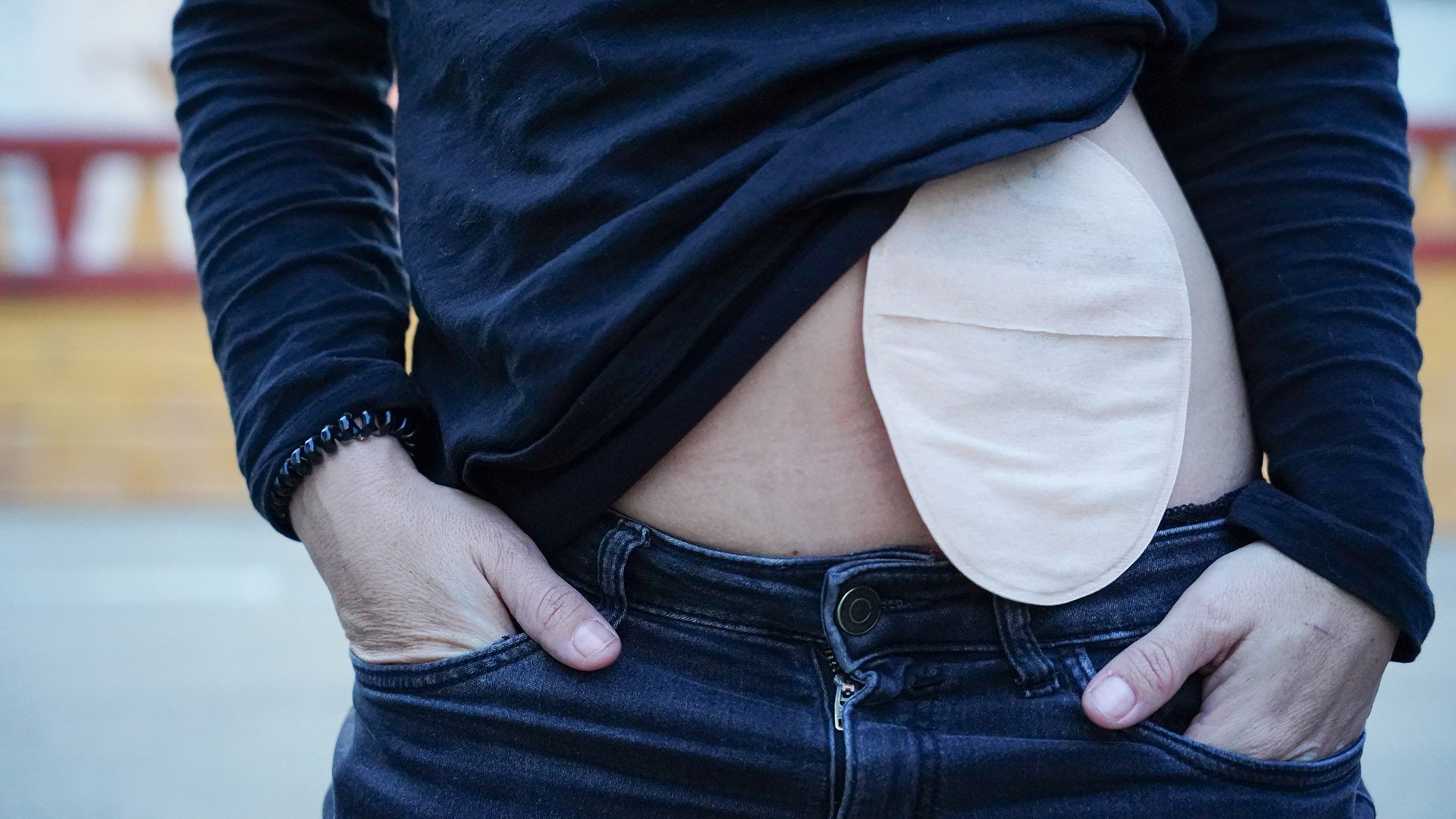Ostomies
Some survivors need to live with an ostomy after cancer treatment. An ostomy is a surgical opening from an organ inside the body to the outside of the body. This allows waste to empty into a pouch outside the body or for nutrients to enter. Knowing how to manage daily life with an ostomy can help you live your life with confidence.

Due to surgical advances, a relatively few number of cancer survivors need an ostomy. But for those who do, it can be a life-saving surgery. Ostomies can be temporary or permanent. A temporary ostomy allows healing to an area of the bowel or bladder below the ostomy. A permanent ostomy may be needed if the location of the cancer requires that the end of the colon (rectum), the entire colon or the entire bladder be removed.
Most ostomies for cancer survivors are done during the first stages of surgical treatment to remove the cancer. However, some may be done months or years later. If cancer affects the bowel or bladder, there may be a need for a colostomy, a urostomy or in rare situations, both (see below).
Common ostomy types in cancer survivors:
- Colostomy: A surgical opening from the large bowel or colon to the abdomen to allow fecal matter to pass to the outside of the body.
- Ileostomy: An opening in the ileum, a part of the small bowel, to the abdomen. Small bowel contents can pass through to the outside of the body.
- Urostomy: An opening in the urinary system where urine can pass to the outside.
Less common ostomy types in cancer survivors:
- Jejunostomy: Opening into the jejunum, a part of the small bowel, to allow feeding.
- Gastrostomy: Opening from the stomach to the outside of the body, to allow feeding.
- Tracheostomy: Opening from the trachea to protect the airway.
- Internal ostomies: A surgical opening between two internal organs rather than bringing one opening out to the surface of the body.
Cancers that Can Require an Ostomy
Ostomy surgery can be performed on people of all ages, including infants. A small number of patients may require two ostomies: one into the bowel and one into the urinary system. An ostomy may be needed if cancer spreads to the bladder or rectum. This is more likely in cancers close to the bladder and rectum, such as cervical cancer and prostate cancer. Here are some cancers that could result in an ostomy surgery:
- Ovarian cancer: Cancer of the ovaries may spread in the abdominal cavity, obstructing either the small or large intestine and could require an ileostomy or colostomy.
- Small bowel cancer or ovarian cancer: If cancer has spread to the small bowel an ileostomy may be made.
- Rectal cancer: If the rectum is removed, a colostomy is made.
- Cervical cancer: Because the cervix and the uterus are between the bladder and the rectum, there may be a urostomy or colostomy.
- Bladder and urethra cancer: If either the bladder or urethra is removed, a urostomy is formed.
- Small intestine cancer: If cancer affects the small bowel, an ileostomy may be formed.
- Colon cancer: Depending on the location of cancer in the colon, a colostomy may be required.
- Prostate cancer: Because the prostate lies just above the rectum, surgery or radiation to the area may require a colostomy.
- Uterine cancer: Because the uterus lies below the bladder and above the rectum, surgery or radiation to the area may require a colostomy or a urostomy.
- Cancers of the lymph nodes: If it spreads to the bowel.
An ostomy may also be needed because of treatment side effects from radiation therapy or surgery. These are some side effects from treatment that may require an ostomy:
- Radiation to the prostate or cervix may cause a change in the bowel or bladder that interferes with eliminating waste.
- Severe bladder or bowel irritation.
- Chronic bleeding after radiation to the uterus, bowel or prostate gland.
- Bowel obstruction after surgery.
Living With an Ostomy
A person with an ostomy can lead a normal life.
- Work: It’s possible to resume normal work activities. People with ostomies are from all walks of life including professional athletes, teachers and lawyers.
- Recreation: People with ostomies can continue to do the activities they enjoyed before surgery including exercising, biking, swimming and hiking.
- Diet: Individuals with an ostomy quickly learn about the best foods for them as well as about the foods that cause discomfort or other problems.
You’ll need to think about ways do some activities differently. Work with your health care team to make adjustments in your life, such as:
- Medications: Inform your pharmacist if you have an ostomy. There are certain medications that can cause difficulties with a colostomy or urostomy. Tablets and capsules must dissolve before they are absorbed.
- For colostomies: Foods that cause gas or odor are the same foods that were likely a problem before the ostomy. Common culprits can be beans, onions, cabbage, and spicy foods. If you have this concern, try to avoid those foods. Medication-induced constipation can be a problem. Sedatives and pain medications are associated with constipation.
- For ileostomies: Certain foods need to be chewed very well or avoided if they cause cramping or difficulty passing through the ostomy. These include corn, popcorn and nuts. It’s important to know which foods cause diarrhea, which can cause an excessive loss of fluids and lead to dehydration. Ask your pharmacist about medications after an ileostomy. Antibiotics and antacids can cause diarrhea. A sustained release 12-hour medication may not work well. A liquid formation of your medication may work better because it is absorbed faster.
- For urostomies: Some medications can cause urinary stones. If you are taking a fluid pill, be aware that your pouch will need to be emptied more frequently. Many survivors with a urostomy take vitamin C for odor control.
- Clothing: You can wear the same kind of clothing as before surgery. Loose clothing may feel more comfortable over the pouch. However, many survivors with an ostomy wear bathing suits or other close-fitting clothes without difficulty. The best rule is to wear clothes that feel comfortable.
- Bathing: An ostomy is like the tissue in found in the mouth or anus. Water will not hurt it. Bathing, showering and swimming are okay. The skin around the ostomy needs to be cleansed and dried. The health care team should be informed if redness or special care is needed for the skin under the pouch.
- Sexual activity: There may be feelings of embarrassment because of an ostomy. Some survivors fear rejection from a partner. In most cases, the partner is likely to feel relieved to have you home and not be concerned about these types of changes. Try to have an open discussion about your concerns with your partner. After surgery, you may want to resume intimacy in stages starting with cuddling, kissing and caressing. As you gain confidence and become more comfortable with your ostomy, you can enjoy your pre-surgery sexual activities. Sexuality is about intimacy with your partner and no cancer treatment or ostomy has to end this important part of who you are. If you or your partner has concerns about sexual activity, talk with your health care team.
Seek Support
- Learn how others manage their lives with an ostomy. Share your concerns and feelings with your health care team and with people you trust.
- Find support groups in your area: Ask a member of your health care team for suggestions. Contact Livestrong Cancer Navigation Services at Livestrong.org or call (855) 220-7777.
- Find an ostomy nurse in your community. Ask your health care team for recommendations.
- Learn how to care for your ostomy. Make it a goal to become independent in your care unless you are physically unable to care for your ostomy.
Having an Ostomy during Cancer Treatment
Some cancer survivors with an ostomy require other cancer therapies along with the ostomy surgery. Here are some issues to consider:
- Chemotherapy: A survivor may realize that assistance is needed to care for the ostomy if he or she feels sick or tired after chemotherapy. Some medications may have side effects that affect the ostomy. Let your health care practitioner examine your ostomy during follow-up visits. Take an extra pouch so you can remove yours for the examination. Stop irrigations when you have diarrhea, if you have a colostomy.
- Radiation: Radiation is an integral part of cancer treatment for many survivors. If the ostomy is in the marked field of radiation, you may have to remove your pouch for each treatment. Carry a spare pouch with you for all medical visits because the office may not have a pouch that fits your ostomy. Radiation may cause skin changes around your ostomy. Make your radiotherapy health care team aware of any changes with your ostomy or your skin. If diarrhea occurs during radiation therapy and you have a colostomy or an ileostomy, alert your nurse. Take your supplies with you to the hospital or clinic. Inform health care providers that you have an ostomy and let them know how about your care methods.
The bodily changes like this can affect body image. Remember that your value as a person has not changed because of an ostomy. People will be unaware of it unless you tell them. You can live a normal and fulfilling life. Your health care team can answer your questions and help you adjust.

